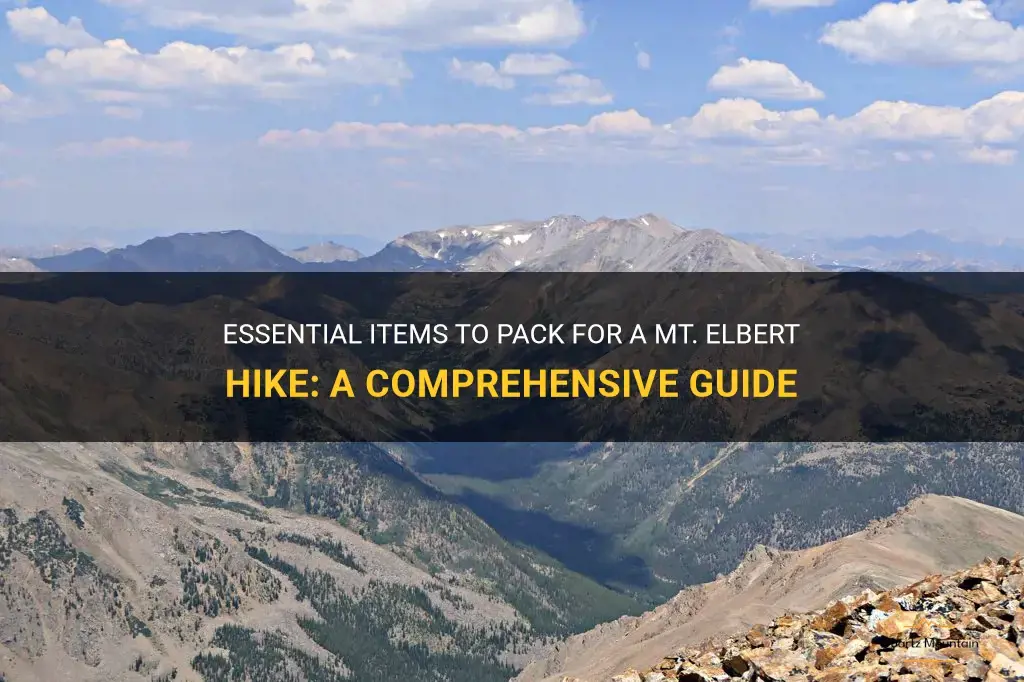
Are you planning to embark on a challenging and awe-inspiring adventure up Mt. Elbert, the highest peak in Colorado? If so, it's crucial to equip yourself with the essential items that will make your hike safe, comfortable, and fulfilling. In this comprehensive guide, we will explore all the must-have gear, clothing, and supplies that you should pack for your Mt. Elbert hike. From sturdy hiking boots to a reliable GPS device, we'll ensure that you are fully prepared to conquer this magnificent mountain and create memories that will last a lifetime.
| Characteristics | Values |
|---|---|
| Elevation | 14,439 ft (4,401 m) |
| Difficulty | Moderate to Difficult |
| Trailhead | North Halfmoon Creek Trailhead |
| Round Trip Distance | ~9.5 miles (15.3 km) |
| Best Time to Hike | June to September |
| Required Permits | None |
| Trekking Poles | Recommended |
| Water Sources | Limited - bring a water filter |
| Clothing | Layered clothing, including warm layers and rain gear |
| Footwear | Sturdy hiking boots |
| Navigation | Map and compass or GPS device |
| Sun Protection | Sunscreen, hat, sunglasses |
| Food | High-energy snacks and meals |
| First Aid Kit | Essential supplies and medications |
| Backpack | Large enough to carry all your gear |
| Camping Gear | Tent, sleeping bag, sleeping pad |
| Communication | Cell phone or satellite phone |
| Cash | For parking fees or emergencies |
| Trash Bags | Pack out all your trash |
| Mountaineering Skills | Ice axe, crampons, helmet (if climbing the more technical routes) |
What You'll Learn
- What essential items should I pack when hiking Mt. Elbert?
- Are there any specific clothing or gear recommendations for hiking Mt. Elbert?
- Should I bring any protective equipment, such as a helmet or sunglasses, for hiking Mt. Elbert?
- Are there any specific food or water requirements for hiking Mt. Elbert?
- Is there anything I should be aware of in terms of safety gear or emergency supplies when hiking Mt. Elbert?

What essential items should I pack when hiking Mt. Elbert?
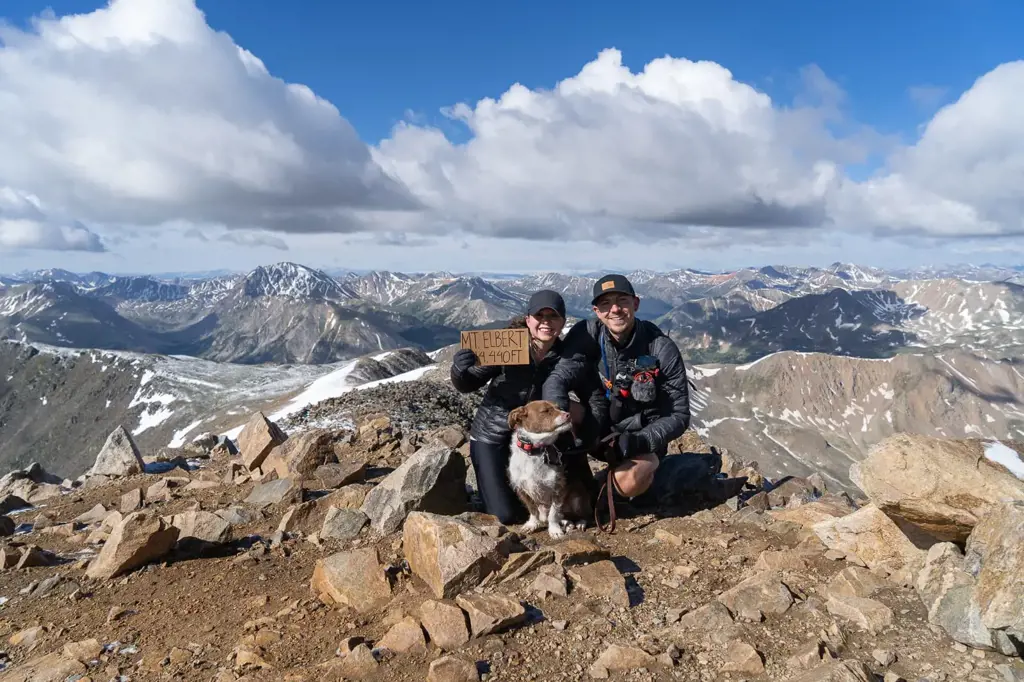
When hiking Mt. Elbert, the highest peak in Colorado and one of the most popular hiking destinations in the state, it is important to pack essential items to ensure a safe and enjoyable journey. Here are some items that you should consider when preparing for your hike:
- Backpack: A sturdy backpack is essential for carrying all your gear. Look for one that fits comfortably and has multiple compartments for organizing your supplies.
- Hiking boots: Invest in a good pair of hiking boots that provide ankle support and have a sturdy sole with good traction. This will help you navigate the rocky terrain and prevent injuries.
- Clothing: Dress in layers to be prepared for changing weather conditions. Start with a moisture-wicking base layer, followed by a fleece or down jacket for insulation, and finish with a waterproof and windproof outer layer. Don't forget a hat, gloves, and wool socks to keep you warm.
- Navigation tools: It is important to have a map, compass, and a GPS device to navigate the trail and stay on course. Familiarize yourself with the route before starting your hike and keep these tools handy.
- Water and food: Make sure to carry enough water to stay hydrated throughout your hike. It is recommended to bring at least 2 liters of water per person. Pack lightweight, high-energy snacks like nuts, energy bars, and dried fruits to keep your energy levels up.
- First aid kit: Accidents can happen, so it is important to have a basic first aid kit that includes bandages, antiseptic ointment, pain relievers, and any necessary personal medications.
- Headlamp: A headlamp is crucial in case you find yourself hiking in the dark or needing to navigate through a tunnel or cave. Make sure to bring extra batteries as well.
- Sun protection: The sun's rays can be intense at higher altitudes, so protect yourself with sunscreen, sunglasses, and a hat to shield your face from the sun.
- Emergency shelter: In case of unexpected weather changes or injuries that prevent you from continuing the hike, pack a lightweight emergency shelter like a bivvy sack or a space blanket.
- Communication devices: Carry a fully charged cell phone or a two-way radio for emergencies. It is also a good idea to inform someone of your hiking plans and expected return time.
Remember, in addition to packing these essential items, it is important to be physically prepared for the hike. Train beforehand with regular cardiovascular exercises and hiking to build endurance and strength. By being prepared and equipped with the necessary gear, you can enjoy a safe and memorable hiking experience on Mt. Elbert.
Essential Items to Pack for a Memorable Three-Day Trip in Wales
You may want to see also

Are there any specific clothing or gear recommendations for hiking Mt. Elbert?
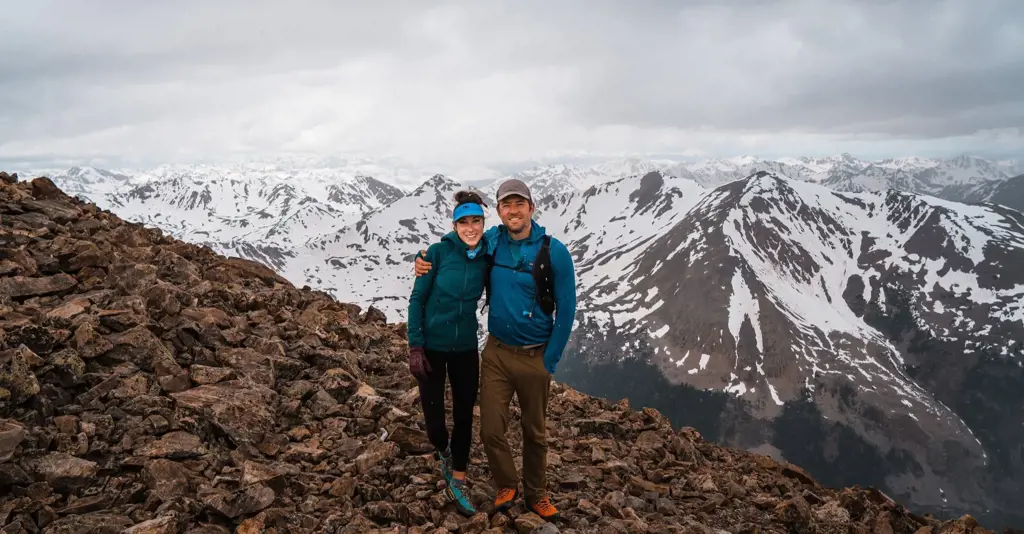
When planning a hike up Mt. Elbert, the highest peak in Colorado and the second-highest in the contiguous United States, it's important to come prepared with the right clothing and gear. The mountain's elevation of 14,439 feet presents unique challenges, including potentially harsh weather conditions and rapidly changing temperatures. Here are some specific recommendations for what to wear and bring when hiking Mt. Elbert.
Clothing:
- Layering is key: Dress in layers to adapt to changing weather conditions. Start with a wicking base layer to keep moisture away from your body, followed by an insulating mid-layer, and top it off with a waterproof outer layer to protect against rain or snow.
- Hiking pants: Opt for lightweight, quick-drying pants that offer freedom of movement. Convertible pants are a popular choice as they can be turned into shorts if the weather gets too warm.
- Moisture-wicking socks: Invest in good quality socks that will keep your feet dry and prevent blisters. Look for options made from synthetic materials or merino wool.
- Sturdy hiking boots: Choose boots that provide ankle support and have good traction for hiking on uneven terrain. Make sure they are broken in before tackling Mt. Elbert to prevent discomfort or blisters.
Gear:
- Backpack: A comfortable backpack with a capacity of at least 30 liters is essential for carrying all your gear, food, and water. Look for one with padded shoulder straps and a waist belt for added support.
- Map and compass: Even if you plan on using a GPS device or smartphone app, it's crucial to carry a physical map and compass as a backup. Familiarize yourself with the route before setting off.
- Water and water purification: Mt. Elbert is a strenuous hike that can take several hours, so it's important to stay hydrated. Carry at least two liters of water and consider using a water purification system, such as a filter or water treatment tablets, to refill your bottle along the way.
- Snacks and energy food: Pack high-energy snacks like trail mix, energy bars, and dried fruit to keep your energy levels up. It's also a good idea to bring a packed lunch if you plan on spending the whole day on the mountain.
- Headlamp: Even if you plan to hike during the day, it's wise to carry a headlamp in case your hike takes longer than anticipated. Choose one with a bright LED bulb and check the battery before setting off.
- Sun protection: The sun's rays can be intense at high altitude, so protect yourself with a wide-brimmed hat, sunglasses, and sunscreen with a high SPF. Don't forget to apply lip balm with SPF to prevent chapping.
These are just some of the clothing and gear recommendations for hiking Mt. Elbert. Remember to also bring along essentials like a first aid kit, a whistle for emergencies, and a trekking pole for added stability and support. Always check the weather forecast before embarking on your hike and be prepared to turn back if conditions become dangerous. With the right clothing and gear, you can have a safe and enjoyable experience hiking Mt. Elbert, taking in the stunning views from the top of Colorado's highest peak.
Essential Items to Pack for Your American University Experience
You may want to see also

Should I bring any protective equipment, such as a helmet or sunglasses, for hiking Mt. Elbert?
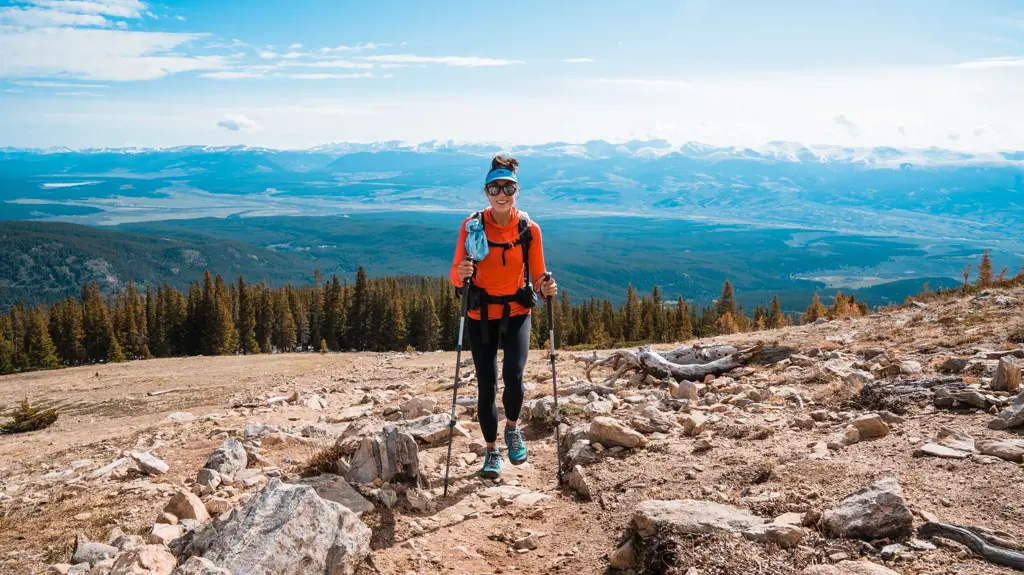
When embarking on a hiking adventure, it is crucial to prioritize safety and be prepared for various conditions. Mount Elbert, being the highest peak in Colorado, presents its own unique challenges. Thus, this article aims to provide guidance on whether you should bring any protective equipment, such as a helmet or sunglasses, for hiking Mount Elbert.
Understanding the Terrain and Potential Risks:
Before delving into specific protective equipment requirements, it is essential to comprehend the terrain and potential risks associated with hiking Mount Elbert. As a 14er, reaching a height of 14,440 feet (4,401 meters), Mount Elbert poses certain dangers, such as unpredictable weather conditions, rocky terrain, and potential rockfall.
Helmet Considerations:
When assessing the need for a helmet, it is crucial to evaluate the nature of the hike. If you plan to hike a standard route with established trails, a helmet might not be necessary. These established trails minimize the risk of accidents from falling rocks or rockfall. However, if you intend to venture off-trail or take more challenging routes, a lightweight climbing helmet can provide an extra layer of protection in case of rockfall or accidental slips.
Sunglasses and Eye Protection:
Regardless of the route you choose, sunglasses or some form of eye protection should always be a part of your hiking gear. The higher elevation of Mount Elbert intensifies the sun's rays, increasing the risk of sunburn, snow blindness, and eye strain. Sunglasses with 100% UV protection and a close fit to shield your eyes from bright light and potential debris are highly recommended.
Other Essential Protective Gear:
While a helmet and sunglasses are the primary protective equipment considerations, several other items are essential for safe hiking on Mount Elbert. These items include:
- Sturdy Hiking Boots: Invest in a pair of hiking boots with ankle support and a gripping sole for traversing the rocky terrain.
- Layers of Clothing: The weather conditions on Mount Elbert can change rapidly, so wearing layers allows you to adapt to temperature fluctuations.
- Sunscreen: Apply a high SPF sunscreen generously to protect your skin from intense UV radiation.
- First Aid Kit: Carry a compact first aid kit with basic supplies for any minor injuries or emergencies.
- Map and Compass: Ensure you have essential navigation tools to navigate the mountain and avoid getting lost.
- Adequate Water and Snacks: Stay hydrated and energized during your hike with plenty of water and nutrient-rich snacks.
Learn from Experienced Hikers:
To gain further insights and learn from others' experiences, consider seeking advice from experienced hikers who have summited Mount Elbert. Online forums and hiking communities can provide valuable information about protective equipment and gear recommendations based on their first-hand experiences.
In conclusion, while a helmet may not be necessary for hiking Mount Elbert's established trails, it is a wise addition if you plan to take more challenging or off-trail routes. Sunglasses, on the other hand, are a must for all hikers due to the mountain's high elevation and bright sunlight. Ultimately, prioritize your safety by assessing the terrain, understanding potential risks, and equipping yourself with appropriate protective gear and equipment to ensure a safe and enjoyable hiking experience on Mount Elbert.
What to Pack for a Romantic Night Away: Essential Items for a Perfect Getaway
You may want to see also

Are there any specific food or water requirements for hiking Mt. Elbert?
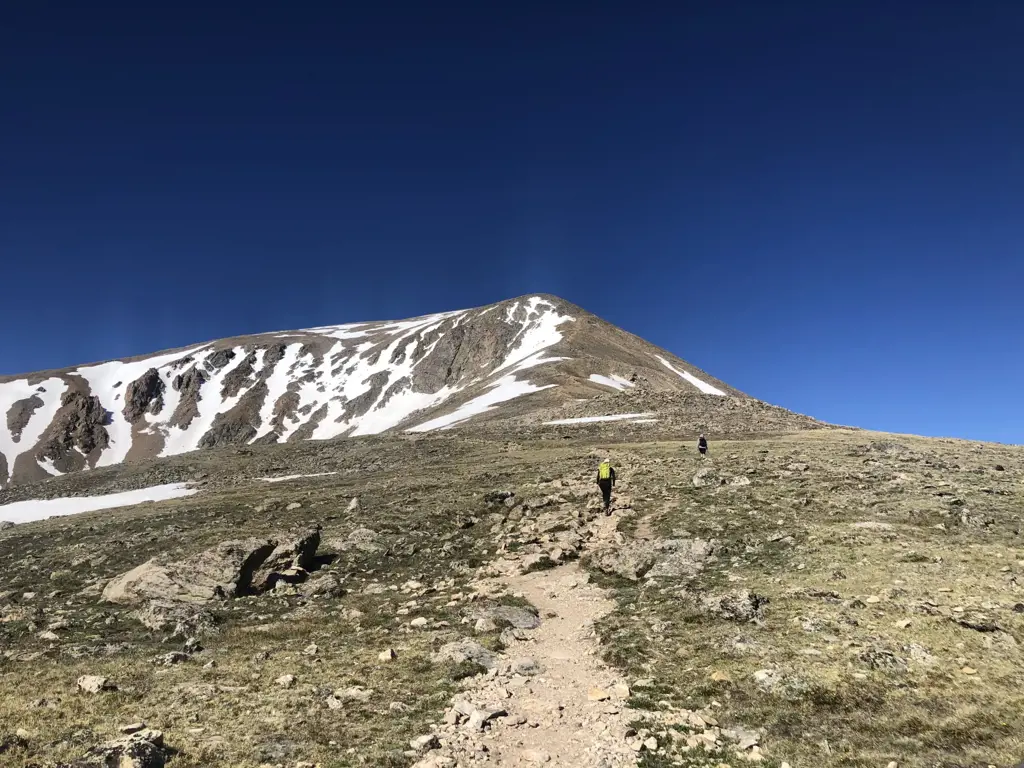
When hiking Mt. Elbert, the highest peak in Colorado, it is important to be prepared not only physically and mentally, but also in terms of food and water. The demanding nature of the hike, combined with the high altitude, requires careful consideration of your nutritional needs. Here are some specific food and water requirements to keep in mind when hiking Mt. Elbert.
- Hydration is key: Staying properly hydrated is crucial when hiking at high altitudes. The arid climate and increased exertion can lead to more rapid dehydration. It is recommended to drink at least 2-3 liters of water per day during the hike. Consider bringing a water bladder or hydration pack to ensure easy access to water while on the trail.
- Pack high-energy snacks: Hiking at high altitudes requires a significant amount of energy. Pack lightweight, high-energy snacks that are easy to eat on the go. Examples include trail mix, energy bars, dried fruits, and nuts. These snacks provide the necessary carbohydrates, proteins, and fats to fuel your body during the hike.
- Include electrolytes: In addition to water, it is important to replenish electrolytes lost through sweat. Consider bringing electrolyte tablets or powders to add to your water. These will help maintain the proper balance of sodium, potassium, and other minerals in your body, preventing muscle cramps and fatigue.
- Carbohydrate-rich meals: Prior to the hike, and during breaks along the trail, consume meals that are rich in carbohydrates. These will provide a sustainable source of energy for your muscles. Options include pasta, rice, potatoes, and whole grain bread. Pair carbohydrates with protein sources like chicken, fish, or beans for a well-balanced meal.
- Plan for altitude sickness: As you ascend to higher altitudes, the risk of altitude sickness increases. This can result in loss of appetite, nausea, and difficulty digesting food. To combat these symptoms, it is important to eat light, easily digestible meals. Avoid greasy or heavy foods that may cause further discomfort. Opt for smaller, more frequent meals throughout the day to keep your energy levels up.
- Consider altitude-specific supplements: Some hikers find it beneficial to take altitude-specific supplements like Ginkgo Biloba or Diamox. These supplements are believed to aid in acclimatization and alleviate some of the symptoms associated with altitude sickness. However, it is important to consult with a healthcare professional before taking any supplements.
In conclusion, when hiking Mt. Elbert, it is essential to prioritize your food and water requirements to ensure a safe and successful hike. Stay hydrated, pack high-energy snacks, replenish electrolytes, consume carbohydrate-rich meals, plan for altitude sickness, and consider altitude-specific supplements. By following these guidelines, you will be better equipped to tackle the challenges of hiking Mt. Elbert and enjoy the breathtaking views along the way.
The Essential Items to Pack When Taking Your Daughter to College
You may want to see also

Is there anything I should be aware of in terms of safety gear or emergency supplies when hiking Mt. Elbert?
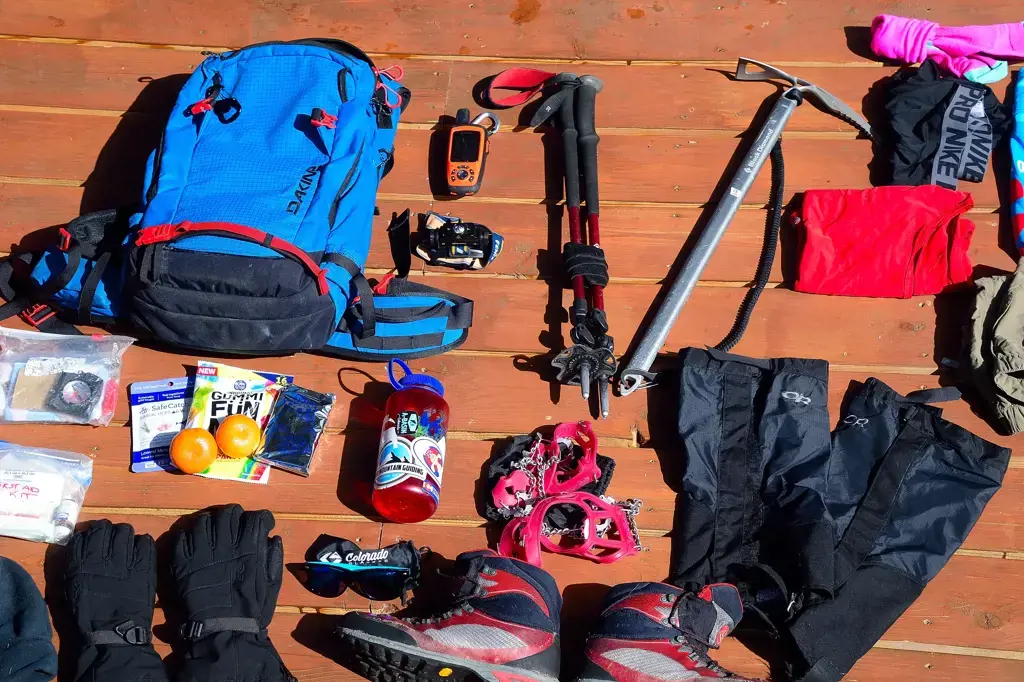
Hiking Mt. Elbert, the highest peak in Colorado at 14,440 feet, is a thrilling adventure that offers incredible views and a sense of accomplishment. However, it is important to be prepared and aware of safety gear and emergency supplies when embarking on this hike. Here are some key considerations:
Clothing and Footwear:
Dress in layers and wear moisture-wicking, breathable clothing to regulate body temperature. Opt for sturdy, ankle-supporting hiking boots to prevent sprained ankles on the rugged terrain.
Navigation Tools:
Carry a detailed map of the trail and a compass to avoid getting lost. Familiarize yourself with the route before setting out and consider using a GPS device or smartphone app to track your progress.
Sun Protection:
At high altitudes, the sun's rays are stronger and can cause sunburn or even snow blindness. Carry a wide-brimmed hat, sunglasses with UV protection, and sunscreen with a high SPF.
Emergency Shelter:
In case of unexpected weather changes or injuries, it is crucial to have emergency shelter. Carry a lightweight, waterproof, and windproof tent or tarp to provide protection from the elements.
First Aid Kit:
Pack a well-stocked first aid kit with essentials like bandages, gauze, adhesive tape, antiseptic wipes, pain relievers, and any personal medications. Be prepared for the most common hiking injuries such as blisters, cuts, sprains, and altitude sickness.
Emergency Communication Device:
While cell phone service may be limited at higher elevations, it is still advisable to carry a fully-charged cell phone for emergency calls. Consider investing in a personal locator beacon (PLB) or satellite phone for reliable communication in remote areas.
Water and Food:
Stay hydrated by carrying an adequate amount of water for the duration of your hike. The general recommendation is to drink at least 2-4 liters of water per day while hiking at high altitudes. Pack high-energy snacks and a nutritious lunch to keep your energy levels up.
Extra Layers and Rain Gear:
Weather conditions can change rapidly in mountainous regions. Pack extra layers of clothing, including a warm jacket, gloves, and a hat. Carry a lightweight, packable rain jacket and pants to stay dry during unexpected rain or snow showers.
Headlamp or Flashlight:
It is essential to have a reliable source of light in case you find yourself hiking in the dark. Carry a headlamp or flashlight with extra batteries to navigate the trail safely.
Leave No Trace Principles:
Practice Leave No Trace principles by properly disposing of waste and minimizing your impact on the environment. Carry a small garbage bag to pack out any trash and dispose of it responsibly.
Remember, Mt. Elbert is a challenging hike, and being prepared is essential for a safe and enjoyable experience. Prioritize safety gear and emergency supplies to mitigate any potential risks and ensure a successful summit of Colorado's highest peak.
Essential Items for a Memorable Teen Summer Trip: What to Pack for a One Night Getaway
You may want to see also
Frequently asked questions
When packing for hiking Mt. Elbert, it is important to bring essential items such as sturdy hiking boots, plenty of water, and adequate food. Additionally, it is also necessary to pack layers of clothing to accommodate changes in weather, including a warm jacket, hat, and gloves. It is advisable to bring a map and compass in case of navigation difficulties, as well as a first aid kit in case of emergencies. Finally, don't forget to bring sunscreen, sunglasses, and insect repellent to protect yourself from the elements.
While hiking Mt. Elbert does not require any special equipment, there are a few essential items that should be brought along. It is recommended to bring trekking poles for added stability and support on the trail. These can help distribute weight and reduce stress on knees and ankles. Additionally, it is a good idea to have a headlamp or flashlight in case your hike extends into the evening or early morning hours. Finally, a good backpack is essential for carrying all of your gear and supplies comfortably.
Yes, camping is permitted on Mt. Elbert, although there are specific regulations and guidelines to follow. Camping is only allowed in designated areas, and it is important to obtain a permit before setting up camp. The closest campsite to Mt. Elbert is the South Elbert Trailhead Campground, where campers can enjoy basic amenities such as restrooms and fire rings. It is recommended to make reservations in advance, as this campsite can fill up quickly. Additionally, it is crucial to follow Leave No Trace principles and properly dispose of all waste to help preserve the natural beauty of the area.







